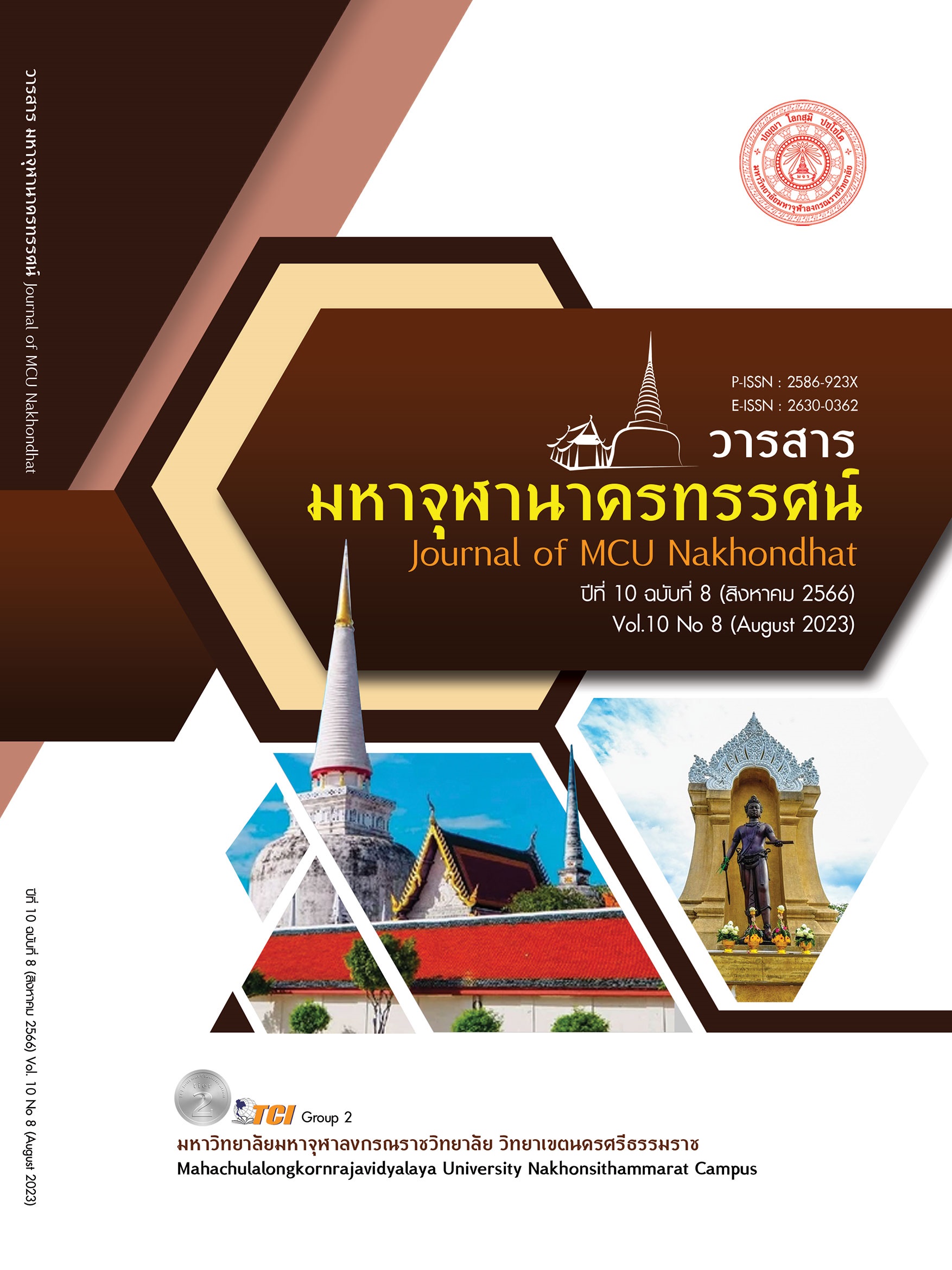STUDY THE BELIEFS, RITUALS AND SUPERSTITIOUS VALUES OF WAT KHAO OR MAKOK NUEA SUB-DISTRICT, KHUAN KHANUN DISTRICT, PHATTHALUNG PROVINCE
Main Article Content
Abstract
This research is a study on “Study of beliefs, rituals and superstitious value of Khao Or Temple, Makok Nuea Subdistrict, Khuan Khanun District, Phatthalung Province” focusing on 1) To study superstitious beliefs and rituals 2) To study superstitious beliefs and rituals of Khao Or Temple 3) To study the value of beliefs and rituals The superstition of Wat Khao Or that affects society in various aspects. The results showed that 1) Superstition beliefs and rituals reflect the roles of members in the community, feeling of being part of the community. society or nation lead to the strength of the community which has been with society for a long time though reproduction until it becomes the identity of the community as the cultural heritage of the community. 2) The superstitious rituals of Khoa Or Temple consist of accepting disciple rituals. Holly water ceremony Neem Ritual the ritual of eating aloe vera Wan Ya Ritual Ritual to eat black glutinous rice Ritual of eating raw sesame oil Ceremony of making amulets and amulets. Beliefs change according to social and economic conditions and the practices of the successor monks. 3) The superstitious beliefs and rituals of Wat Khao Or had an impact on society in various values, spiritual values. social value economic value cultural The value of the maintenance of Buddhism, the value of tourism Various values lead to peaceful coexistence in society. As long as the practitioner continues to adhere to the principles of that ritual. Which will be beneficial to the development of Buddhism and local culture.
Article Details

This work is licensed under a Creative Commons Attribution-NonCommercial-NoDerivatives 4.0 International License.
References
จุฬารัต ผดุงชีวิต. (2558). อ่านวิพากษ์ มิเชล ฟูโกต์. กรุงเทพมหานคร: สยามปริทัศน์, สนพ.
ณัชรดา สมสิทธ์ และวราเมษ วัฒนไชย. (2559). มุมมองและแนวคิดที่ปรากฏจากพิธีกรรมการแช่ว่านรางยา อำเภอควนขนุน จังหวัดพัทลุง. วารสารรูสมิแล, 37(1), 38-55.
เดชชาติ ตรีทรัพย์ และคณะ. (2558). หลักธรรมที่ปรากฏในความเชื่อและพิธีกรรมทางไสยศาสตร์สำนักเขาอ้อ จังหวัดพัทลุง. วารสาร มหาจุฬานาครทรรศน์, 2(1), 42-48.
ทิวาพร จันทร์แก้ว. (2550). พิธีกรรมและความเชื่อในพื้นที่ลุ่มน้ำทะเลสาบสงขลา. ใน เอกสารการประชุมวิชาการด้านมนุษยศาสตร์และสังคมศาสตร์ระดับชาติครั้งที่ 2 สาขามนุษยศาสตร์และสังคมศึกษา. มหาวิทยาลัยราชภัฏสงขลา.
ธยายุส ขอเจริญ และคณะ. (2562). พลวัตวัฒนธรรมของประชาชนตามแนวชายแดนไทยกัมพูชา : คติความเชื่อและการละเล่น. วารสาร มจร อุบลปริทรรศน์, 5(3), 179-192.
เพลินพิศ พรหมเกษ. (2552). การเกิด : มุมมองความเชื่อประเพณีและพิธีกรรม. วารสารศิลปะและวัฒนธรรมลุ่มแม่น้ำมูล, 4(1), 50-60.
ศรีศักร วัลลิโภดม. (2540). ราชอาณาจักรไทยในรอบ 5 ทศวรรษแห่งการครองราชย์. กรุงเทพมหานคร: กองวรรณกรรมและประวัติศาสตร์, กรมศิลปากร.
ศุภการ สิริไพศาล และอภิเชษฐ กาญจนดิฐ. (2550). พิธีกรรมและความเชื่อของชาวไทยเชื้อสายจีน บริเวณลุ่มน้ำทะเลสาบสงขลา จากอดีตจนถึงปัจจุบัน. ใน รายงานวิจัย. สำนักงานคณะกรรมการวัฒนธรรมแห่งชาติ กระทรวงวัฒนธรรม.
สมเด็จพระญาณสังวร (เจริญ สุวฑฺฒโน). (2530). ประมวลสารคดีธรรม. กรุงเทพมหานคร: โรงพิมพ์การศาสนา.
อภิชัย โพธิ์ประสิทธิ์ศาสต์. (2527). พระพุทธศาสนามหายาน. กรุงเทพมหานคร: สภาการศึกษามหามกุฏราชวิทยาลัย.
อภิสร มีผล. (2554). การศึกษาศรัทธาในฐานะปัจจัยเกื้อกูลต่อการเข้าถึงเป้าหมายของพระพุทธศาสนา. ใน วิทยานิพนธ์ สาขาพระพุทธศาสนามหาบัณฑิต. มหาจุฬาลงกรณราชวิทยาลัย.
เอกวิทย์ ณ ถลาง. (2530). ภูมิปัญญาชาวบ้านสี่ภูมิภาควิถีชีวิตและกระบวนการเรียนรู้ของชาวบ้านไทย. นนทบุรี: มหาวิทยาลัยสุโขทัยธรรมาธิราช.


